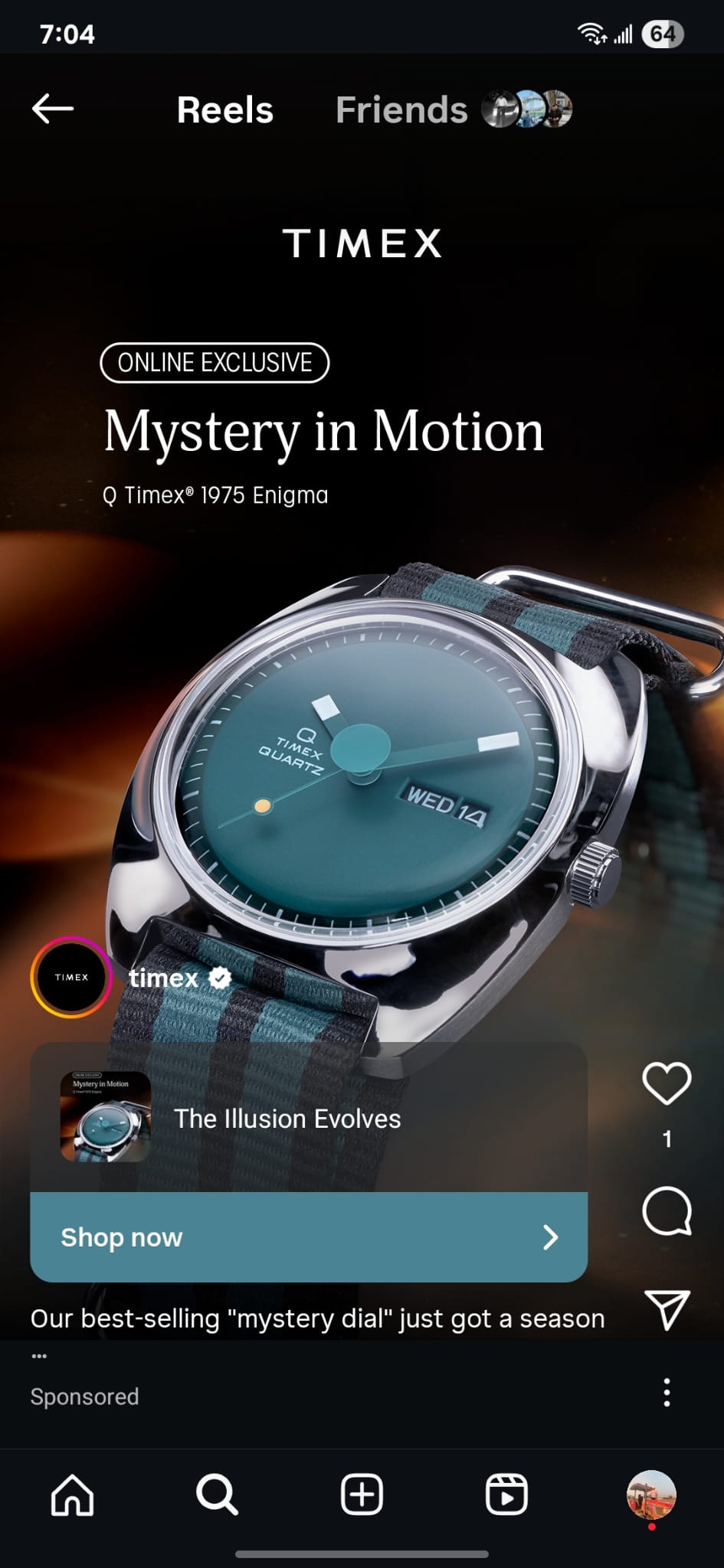#TIMEX While scrolling through Instagram Reels, I saw a sponsored ad from Timex advertising its Q Timex 1975 Enigma watch, referred to as “Mystery in Motion.” The ad was short and elegant, a time-looping watch based on ad that had been specifically designed for the Instagram platform. It presented the product as not only a watch but as a kind of optical illusion, with the tagline “The Illusion Evolves.” This ad stood out to me because of how it framed time, technology, and style as something mysterious and exclusive. Although it did not explicitly state ecological or social responsibility, Timex has increasingly become a brand that identifies with sustainable design choices, like more durable mechanical watches, recycling packaging materials, and energy-efficient manufacturing. The advertisement consequently takes up the ground of luxury, nostalgia, and a subtle ecological undertext: buying a long-lasting timepiece is presented as being stylish as well as responsible.
The advertisement visually focused on a close-up of the watch dial. The watch is propped against a dark background, with light accentuating the high gleam of the steel case and the deep teal-green of the face. The strap, a striped black and green band, complements the dial in a decorous arrangement of visual accommodation. At the center, the dial itself becomes the focus, its odd “mystery hands” floating unsupported. The typography—”Mystery in Motion”—is clean, modern, and white on black, highlighting the sleekness and high-end exclusivity of the product. The insertion of “Online Exclusive” implies urgency and scarcity. The entire composition guides the eye of the viewer towards the watch both as a object of longing and a technological enigma. Similar to most high-end advertising, the background is vague, directing attention towards the product itself.
The message that is being delivered is one of sophistication and exclusivity. The “Mystery in Motion” description suggests that the watch, while functional, is mysterious and artistic. The use of green, a color traditionally associated with peacefulness, nature, and responsibility, subtly creates a connection between product and environmentally friendly values, even though the ad never refers to environmentalism. This sort of semiotic layering is common in advertising: consumers place cultural meanings on colors and symbols, and firms use this to naturalize specific values. Here, Timex presents itself as contemporary, ageless, and harmonious with ethical consumption. By suggesting the watch is “online exclusive,” the ad also participates in the attention economy, using scarcity and digital targeting to convert scrolling into purchases.
As an online shopper in my twenties, I am part of the company’s target demographic. Timex is appealing to people who adore retro style, with the watch referencing the 1970s heritage but also who live in a digital buying landscape where uniqueness and decision speed matter. I was drawn in by the ad visually—the steel and teal made me feel fresh and contemporary, and the floating hands intrigued me. But, my response was complicated. While I adored the aesthetic, the environmental stewardship implication was not strong. The ad is not explicit in selling sustainability, but in its use of durability and classic style, it suggests indirectly that it’s better to buy a Timex than fast fashion. It’s appealing, yet also in danger of being perceived as another greenwashing campaign, where green values are suggested but not outright achieved.
In light of the broader practices of the firm, this tension becomes more apparent. Timex has promoted repair-minded and durability-driven initiatives, emphasizing timepieces that last many years compared to discardable fashion styles. It aligns with opposition to fast fashion and wastefulness of continually replacing consumer goods. But sustainability reports say while Timex has adopted recycled materials for some packaging, there is still quite a bit of globalized production with very little disclosure on supply chains.¹ Scholars like Delmas and Burbano have maintained that most firms adopt “green” branding strategies without the requisite changes in production, calling the phenomenon greenwashing.² In Timex, the environmental appeal is modest but made nonetheless: durability as sustainability. But the query arises whether longevity alone can characterize responsible practice in a world where production and materials remain heavily balanced against the environment.
What makes this ad effective is the way that it combines visual design and semiotics to reconcile product identity and consumer values. The teal color conveys responsibility and sophistication. The “mystery dial” design symbolizes innovation, providing the observer not just a watch but also a tale of technology and intrigue. The phrase “The Illusion Evolves” frames the performance of time-telling as a spectacle. This aligns with what Sut Jhally has described as the capacity of advertising to commodify something and convert it into a symbol of more abstract importance.³ In this specific case, the watch stands for mystery, tradition, and duty and not just usability. But the advertisement is also demonstrating the way the commercial gaze works: abstracting the product from broader contexts (working, materials, environmental impact) and presenting it to us in its pure form and story. Individuals are not present in the advertisement—what we are supposed to identify with is not a lifestyle or group but the watch itself as mysterious object.
In the end, Timex’s “Mystery in Motion” advertisement did catch my eye. It was visually compelling, pleasingly composed, and fitting for the fast-paced limits of Instagram Reels. As a member of its intended audience, I could see myself being drawn in by the item. But my critical mind also recognizes the limits of its environmental and social claims. The advertisement suggests timelessness and responsibility but leaves out material production realities. As with a great deal of contemporary advertising, it triumphs by aestheticizing responsibility rather than completely putting it into action. What is strong about the advertisement is that it leads us to think buying a watch can connect us to mystery, heritage, and even responsibility. But its weakness is that these values are symbolic.
Bibliography
Greenpeace International, Throwaway Consumption and the Watch Industry (Amsterdam: Greenpeace, 2022).
Magali A. Delmas and Vanessa C. Burbano, “The Drivers of Greenwashing,” California Management Review 54, no. 1 (2011): 64–87.
Sut Jhally, The Codes of Advertising: Fetishism and the Political Economy of Meaning in the Consumer Society (New York: Routledge, 2014)


Rawle Fletcher
I think you did a really solid job describing and analyzing the Timex “Mystery in Motion” ad. You clearly explained how the watch was presented on Instagram Reels, especially the way the floating hands, dark background, and sleek typography create a sense of mystery and exclusivity. Your discussion of greenwashing stood out, you didn’t just say they’re being eco-friendly or they’re greenwashing,” you actually unpacked how the ad uses color (teal and green), nostalgic styling, and subtle ecological messaging to imply environmental responsibility without making direct claims. Pointing out the tension between Timex’s marketing and their limited supply chain transparency was a smart move and shows good critical thinking.
Your main points were clear and well developed: you focused on how the ad uses visual semiotics to frame the watch as sophisticated and mysterious, how it builds a sense of luxury and scarcity, and how it connects these ideas to subtle environmental undertones. I also liked that you reflected on your own position as part of the target demographic. That made the critique feel personal and grounded.
You used strong scholarly sources too. The references to Greenpeace, Delmas and Burbano, and Sut Jhally fit well with your arguments and gave the piece some solid academic weight.
One thing you could have explored more is the role of Instagram as a platform in shaping how this ad works. You mentioned Reels, but a bit more on how digital targeting play into the overall strategy would have deepened your critique. It also might have been interesting to touch on how viewers might resist or reinterpret the ad’s messaging.
Overall, it’s a thoughtful, well researched piece with a good balance of description and critique.